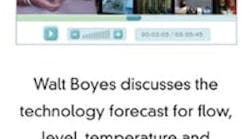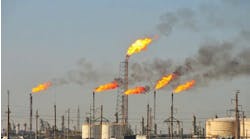Over the past two centuries, we have developed over 11 different ways to measure flow. Each of the techniques has a set of applications for which it is best. There are several technologies that we’ve designed to measure pressure as well. Sometimes we use the differential of a pressure signal as a way to compute a flow value. Sometimes we use pressure to compute level. Level can be measured mechanically, invasively, non-invasively and by entirely non-contact means. And temperature is one of the first process measurements we tried to measure, because so many chemical reactions, from cooking to plastics manufacture, require control at a given temperature.
Indeed, we’ve covered a long list of advances in primary process measurements in Control’s first twenty years, and we expect to continue to do so for the next double decade, too.
So what will some of those advances be? In flow we’ll see the cost of sensors coming down drastically, and the accuracy going up, which will make more applications measurable. We may even see new flow technologies to complement the Coriolis, vortex, magnetic, ultrasonic and mechanical devices we currently use. The same factors will come into play with level, pressure and temperature.
But what will be truly different is the way we will use many of these sensors. You’ll see us using sensor arrays—groups of identical sensors, ganged together using smart software to process the multiple signals into a single coherent reading. Some companies, like CiDRA, have already moved in this direction.
Why is this important? And why is it different? Back in the day, it was necessary to have a single transducer in a single analog control loop. So the transducer had to be as accurate and as repeatable as possible.
But the technology exists, and the software exists, to use multiple groupings of simple, less accurate (and also less costly) sensors, and make highly accurate measurements using the aggregated signals.
For example, process pipelines often have to be heat-traced and insulated to keep the process at the optimum temperature when transferring product from one vessel to another. A very simple application of these sensor arrays would be to put several dozen simple temperature sensors on the skin of the pipe all the way down its length and use the processing software to produce a visual image of the temperature gradients inside the pipe.
CiDRA’s flowmeter uses an array of acoustic pressure sensors to detect flow vortices, bubbles and entrained gas in the line non-invasively. This detection produces values for both flow and void fraction, so that the product flow can be compensated for density automatically.
How about monitoring the temperature all the way through a reactor vessel in real time? Or watching pressure surges in a pipeline in real time so that you can identify fluid hammer before the pipeline breaks?
One of the other technologies that will create synergy with lower cost sensors is the use of wireless. Hanging 30 wired pressure sensors all around a vessel is impractical, expensive and uses substantial I/O in the control system. But taking those 30 sensors wirelessly to a smart level analyzer with a single output to the control system is most certainly practical, and we’ll see it done.
And we may actually see new primary process variables joining the venerable Big Four. It could be that the simple wet chemistry variables of pH, conductivity, ORP and resistivity may yet become as ubiquitous as the Big Four. New research may make corrosion a process variable as often monitored as flow or level.



